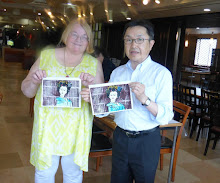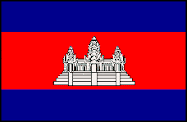About
Okay now, it was built in 1984 and is a wooden replica of Sultan Mansur Shah's palace, he's the Sultan who ruled Melaka from 1456 to 1477. This building is built of only two types of hardwood, 'chengal' and 'rasak', and the roof is made of 'belian' wood. And ... no nails were used in the construction of the building, only wooden pegs. That's amazing. To think that they built this huge palace and only used wooden pegs. Wow! Bet there wouldn't be too many able to do that!
The museum cost the Malaccan government RM2.5million to build and was officially opened to the public on 17th July, 1986 by Malaysia's Prime Minister Dato' Seri Dr. Mahathir Mohamad. There's over 1,350 items including prints, photographs, drawings, and artefacts representing the history and cultural heritage of the Malay Sultanate of Malacca and the various communities who came to settle here during that period.
The palace has a ground floor (well obviously) and two upper floors and is divided into eight chambers and three galleries including chambers of the Royal band, weaponry, decorative arts, emissaries and gifts, a recreation hall, an audience hall and an Islamic hall.
IN some of the galleries, you learn about the famous clash between the legendary warriors Hang Tuah and Hang Jebat, there's these beautiful traditional costumes and the pièce de résistance - the royal bedchamber! There are a lot of exhibits - prints and photographs of the Malacca Sultanate, a model of the Sultan Mansur Shah Palace (I took a photo of that), Malay weapons, Malay traditional wedding dress, jewellery and brass ware. I remember reading about those warriors and there were models of them but my camera isn't all that good when I take indoor shots and the light is poor, so I restricted myself to taking just a few photos which I knew would come out alright.
Above: Entrance gate
You walk through this gate, the entrance fee is 2 ringgit and you get given a plastic bag for your shoes. You aren't allowed to wear shoes when you go inside (the building). I can understand that, because if you have hundreds of people all going through, the floor would get damaged. From here it's just a short walk to the palace itself.
Above: Palace of the Malay Sultanate of Malacca
I just adore the steep roof and gables - not only are they appealing to look at, the steepness aids in deflecting heat and helps in keeping the indoors cool.
Above: Front entrance
At the top of the stairs is a wooden verandah and these two fearsome warriors standing guard. I wouldn't like to upset them - those spears look awfully sharp!
You can see the beautiful detail surrounding the doorway - hand crafted designs, fancy gold leaf surround the entrance. It truly is a work of at. I wonder how many hours and how many artisans it took to create this?
Above: Scale model
For this photo, I have cropped it and chosen a wide width to better show the model. There is a sign in front with information, but unfortunately I forgot to take a photo of it.
Above: Boardgame
These two young lasses are playing a game, the name of which I do not know. It obviously isn't draughts, don't think it's chess (not that I know how to play chess). If any of you reading this know the name of the game, could you please leave a comment and let me know? It'd be really good to find out what it's called and much appreciated. (Thanks)
Above: Audience Hall
This is what is known as a diorama which is a three-dimensional full-size or miniature model. It shows the audience hall of the Sultan. In Malay, this hall is called Balairong Ser.
Above: Explanation of hall
As you can see, I've taken a photo of the information board which explains who the people are. If you click on the photo to enlarge it, you can read the writing. The left page is in Malay, the right side of the page is in English. Whilst I or you, might not know who the figures are, there can be no doubt as to which one is the Sultan! He's the chap at the very end in gold.
Above: Kris (dagger)
This is one of the daggers on display. I've translated from the information card -
"The kris or dagger, is from the Upper Peninsula and has been in use for over 600 years. The kris originated in Java."
With the introduction of firearms in the 16th century by European powers, the kris started losing popularity as a battle weapon. Today it is seen as a ceremonial piece.
Wicked looking thing isn't it? Could do a lot of damage that.☺
Above: Royal bedchamber
The pièce de résistance - the Royal Bedchamber. Ooh La La - imagine sleeping in this. Isn't it magnificent? I love the colours. And a four poster too. It ticks all the boxes!
In Malay, it is known as Balai Beradu.
Above: Sultan Mansur Syah's tombstone
There was a plaque with information about this tombstone and it reads -
The tombstone of Sultan Mansur Syah of Malacca who reigned from 1456 until his death in 1477. This tombstone was probably moved from its original place by the Portuguese in 1511 and was found on St. Paul's hill, Malacca in 1918. It was later kept in the Raffles museum Singapore and was returned to the National Museum in 1954.
The world is but transistory; the world has no permanence;;
The world is like a house made by a spider......
Above: Tun Teja's tombstone
There's a tombstone of a Malay princess near the Sultan's and I've copied the information -
Tun Teja was the daughter of Seri Amar Diraja, the Bendahara of Pahang who later became the Queen of Sultan Mahmud Shah (1488 - 1511). This tombstone is only a replica of the actual gravestone which is located at Pengkalan Samak, Merlimau about 24 km from the town of Malacca.
I couldn't help thinking about the poor Princess, no big, grand words for her even though she was a Royal, just a few simple lines. But I bet if she'd been a Prince she'd have had a far more detailed eulogy.
A Bit of Trivia
The Malacca Cultural Museum was first inaugurated in March 1954 by the then Resident Commissioner of Melaka, G.E.C. Wisdom, C.M.G., in a Dutch house built around 1660. The Cultural Museum was later moved to the Stadhuys in 1982 before it was finally moved into the Melaka Sultanate Palace.
Next: The Forbidden Garden Of The Palace Of The Malay Sultanate Of Melaka.























No comments:
Post a Comment